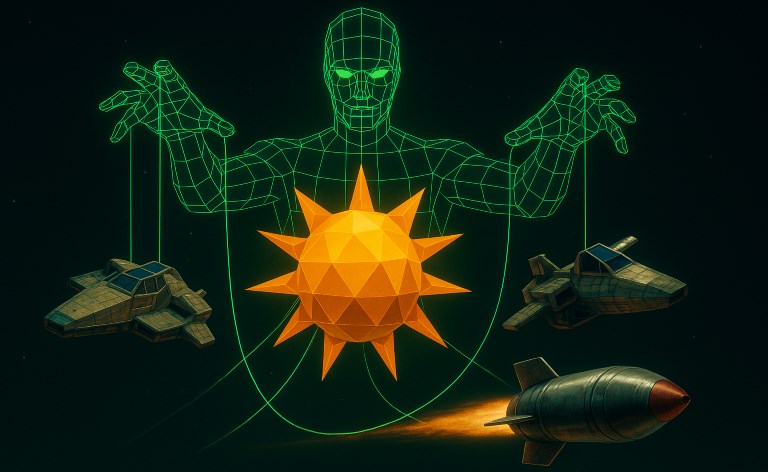
When people talk about the first true 3D video games, titles like Quake or Super Mario 64 often take the spotlight. These games marked a significant leap forward with fully texture-mapped environments, perspective-correct projection, and dynamic camera control. But this view tends to overshadow a rich decade of 3D experimentation on much less capable machines. To truly appreciate the origins of 3D gaming, we need to roll back to the 8-bit and 16-bit eras, where pushing polygons was a brutal, low-level grind, limited by memory, math, and raw CPU cycles.
The 8-bit Foundations
Writing a 3D game on an 8-bit system like the Commodore 64 or ZX Spectrum was a challenge of epic proportions. These systems had CPUs like the 6510 or Z80, typically clocked under 2 MHz. RAM was sparse—often 48K or less—and there were no floating-point units or hardware multipliers. Everything had to be done in software, often with 8-bit math stretched to fake 16- or 32-bit results.
Take a 16-bit multiplication on a 6510:
; Multiply 8-bit A by 8-bit B, result in 16-bit
clc
ldx #8 ; loop for 8 bits
lda #0 ; clear result low
sta resultLo
sta resultHi
loop:
lsr B ; shift right B, carry holds current bit
bcc skipAdd ; if bit not set, skip add
clc
lda resultLo
adc A
sta resultLo
bcc noCarry
inc resultHi
noCarry:
skipAdd:
asl A ; shift A left for next bit
rol resultHi
rol resultLo
inx
cpx #8
bne loop
This was the sort of routine you'd write just to multiply two numbers. Think about trying to do vector math, matrix transformations, or projection in real time with this.
Yet somehow, developers managed. Games like Elite delivered wireframe 3D on systems with no right to be doing 3D at all. How? Precomputed tables, integer-only math, and incredibly tight assembly code.
The 16-bit Leap
The 16-bit era (Amiga, Atari ST, early PCs) brought huge improvements: faster CPUs (Motorola 68000, x86), more RAM, and hardware that made color and resolution viable for real-time rendering.
But even then, rendering filled polygons was tough. A scene with more than a handful of polygons meant serious compromises. Occlusion was mostly just backface culling and manual z-sorting. Overdraw was rampant. Color palettes were limited.
The 68000, for example, was a joy compared to 8-bit CPUs—32-bit registers, hardware multiply, and full stack access. But it still had no floating-point unit, so most games still ran on fixed-point math.
3D Rotations
Rotating a point in 3D requires matrix multiplication. In floating point, it’s simple. On an 8- or 16-bit system? You’re manually calculating each axis:
// Rotate point (x, y, z) around Y axis
cosA = cos(angle)
sinA = sin(angle)
x' = x * cosA + z * sinA
z' = -x * sinA + z * cosA
y' = y
On a machine with no hardware multiply or sin/cos functions, these had to be:
A single rotation could take dozens or hundreds of cycles, and you needed one per vertex.
Rasterization
Once vertices were transformed into screen space, you had to fill triangles. On older machines, scanline rasterization was the norm. But drawing a flat-shaded triangle means:
for y from top to bottom:
leftX = interpolateEdge1(y)
rightX = interpolateEdge2(y)
drawHorizontalLine(leftX, rightX, y)
Without hardware blitting or even fast memory access, this could chew up frame time fast. Fixed-point interpolation was the only way to keep things moving at all.
Projection
Perspective projection takes 3D points and maps them to 2D screen coordinates:
screen_x = (x / z) * focal_length + screen_center_x
screen_y = (y / z) * focal_length + screen_center_y
That divide-by-z is dangerous. Division was slow, and precision was poor in integer math. Most systems used reciprocal tables and multiplication instead:
invZ = reciprocal(z) ; precomputed
screen_x = (x * invZ) >> shift
Clipping points behind the camera or too close was another performance headache.
Texture Mapping
Flat shading was hard enough, but texture mapping introduced per-pixel perspective correction, interpolation, and memory access. On early PCs, this became possible with chunky 256-color framebuffers and fast CPUs.
The math alone was rough:
for each pixel in scanline:
u = uStart + (du * x)
v = vStart + (dv * x)
color = texture[u >> 8][v >> 8]
framebuffer[x][y] = color
Add in perspective correction and you're now doing:
u = (u/z), v = (v/z) — per pixel!
This was borderline insane without a 486 or better.
Raycasting — The Shortcut to 3D
When true 3D was too expensive, devs used raycasting—most famously in Wolfenstein 3D. It simulated 3D by casting a ray per screen column into a 2D map:
for each column:
ray = shoot_ray(player_pos, angle)
distance = find_wall_hit(ray)
wall_height = screen_height / distance
draw_column(column, wall_texture, wall_height)
With grid-based maps, DDA (Digital Differential Analyzer) could step through cells efficiently. You only drew vertical slices of wall textures, making it fast enough for 60fps on a 386.
Raycasting had limits—no sloped surfaces, no rooms-over-rooms—but the performance was unbeatable.
Conclusion — Hardware Set the Rules
Looking back, it’s clear that the evolution of 3D games wasn’t just about better ideas. It was about better hardware. Every generation lifted the ceiling a little higher:
Modern devs live in a world of GPUs, shaders, and gigabytes of RAM—but it all started with hand-coded multiply routines and clever math hacks. The next time you rotate a mesh with a single API call, spare a thought for the programmers who had to write `lsr`, `rol`, and `adc` loops just to make a cube spin.



